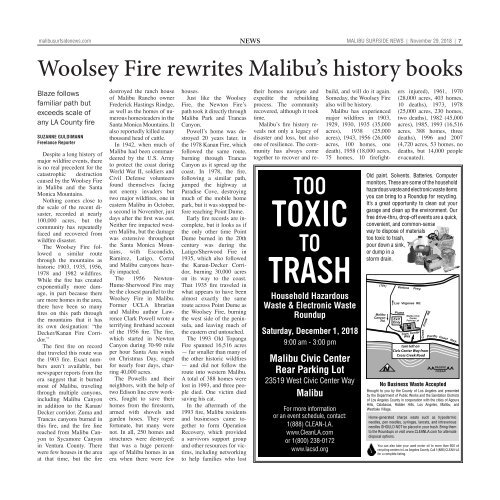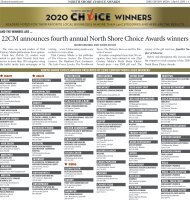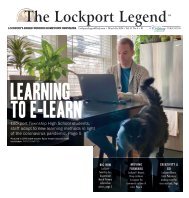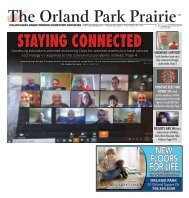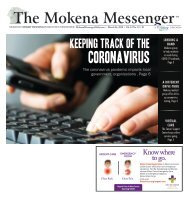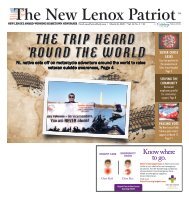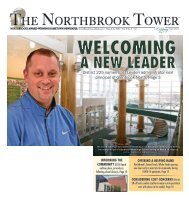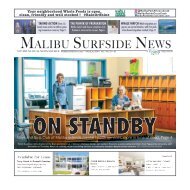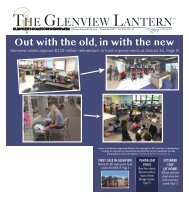MSN_112918
Create successful ePaper yourself
Turn your PDF publications into a flip-book with our unique Google optimized e-Paper software.
malibusurfsidenews.com news<br />
Malibu surfside news | November 29, 2018 | 7<br />
Woolsey Fire rewrites Malibu’s history books<br />
Blaze follows<br />
familiar path but<br />
exceeds scale of<br />
any LA County fire<br />
Suzanne Guldimann<br />
Freelance Reporter<br />
Despite a long history of<br />
major wildfire events, there<br />
is no real precedent for the<br />
catastrophic destruction<br />
caused by the Woolsey Fire<br />
in Malibu and the Santa<br />
Monica Mountains.<br />
Nothing comes close to<br />
the scale of the recent disaster,<br />
recorded at nearly<br />
100,000 acres, but the<br />
community has repeatedly<br />
faced and recovered from<br />
wildfire disaster.<br />
The Woolsey Fire followed<br />
a similar route<br />
through the mountains as<br />
historic 1903, 1935, 1956,<br />
1978 and 1982 wildfires.<br />
While the fire has created<br />
exponentially more damage,<br />
in part because there<br />
are more homes in the area,<br />
there have been so many<br />
fires on this path through<br />
the mountains that it has<br />
its own designation: “the<br />
Decker/Kanan Fire Corridor.”<br />
The first fire on record<br />
that traveled this route was<br />
the 1903 fire. Exact numbers<br />
aren’t available, but<br />
newspaper reports from the<br />
era suggest that it burned<br />
most of Malibu, traveling<br />
through multiple canyons,<br />
including Malibu Canyon<br />
in addition to the Kanan/<br />
Decker corridor. Zuma and<br />
Trancas canyons burned in<br />
this fire, and the fire line<br />
reached from Malibu Canyon<br />
to Sycamore Canyon<br />
in Ventura County. There<br />
were few houses in the area<br />
at that time, but the fire<br />
destroyed the ranch house<br />
of Malibu Rancho owner<br />
Frederick Hastings Rindge,<br />
as well as the homes of numerous<br />
homesteaders in the<br />
Santa Monica Mountains. It<br />
also reportedly killed many<br />
thousand head of cattle.<br />
In 1942, when much of<br />
Malibu had been commandeered<br />
by the U.S. Army<br />
to protect the coast during<br />
World War II, soldiers and<br />
Civil Defense volunteers<br />
found themselves facing<br />
not enemy invaders but<br />
two major wildfires, one in<br />
eastern Malibu in October,<br />
a second in November, just<br />
days after the first was out.<br />
Neither fire impacted western<br />
Malibu, but the damage<br />
was extensive throughout<br />
the Santa Monica Mountains,<br />
with Escondido,<br />
Ramirez, Latigo, Corral<br />
and Malibu canyons heavily<br />
impacted.<br />
The 1956 Newton-<br />
Hume-Sherwood Fire may<br />
be the closest parallel to the<br />
Woolsey Fire in Malibu.<br />
Former UCLA librarian<br />
and Malibu author Lawrence<br />
Clark Powell wrote a<br />
terrifying firsthand account<br />
of the 1956 fire. The fire,<br />
which started in Newton<br />
Canyon during 70-90 mile<br />
per hour Santa Ana winds<br />
on Christmas Day, raged<br />
for nearly four days, charring<br />
40,000 acres.<br />
The Powells and their<br />
neighbors, with the help of<br />
two Edison line crew workers,<br />
fought to save their<br />
homes from the firestorm,<br />
armed with shovels and<br />
garden hoses. They were<br />
fortunate, but many were<br />
not. In all, 250 homes and<br />
structures were destroyed;<br />
that was a huge percentage<br />
of Malibu homes in an<br />
era when there were few<br />
houses.<br />
Just like the Woolsey<br />
Fire, the Newton Fire’s<br />
path took it directly through<br />
Malibu Park and Trancas<br />
Canyon.<br />
Powell’s home was destroyed<br />
20 years later, in<br />
the 1978 Kanan Fire, which<br />
followed the same route,<br />
burning through Trancas<br />
Canyon as it spread up the<br />
coast. In 1978, the fire,<br />
following a similar path,<br />
jumped the highway at<br />
Paradise Cove, destroying<br />
much of the mobile home<br />
park, but it was stopped before<br />
reaching Point Dume.<br />
Early fire records are incomplete,<br />
but it looks as if<br />
the only other time Point<br />
Dume burned in the 20th<br />
century was during the<br />
Latigo/Sherwood Fire in<br />
1935, which also followed<br />
the Kanan-Decker Corridor,<br />
burning 30,000 acres<br />
on its way to the coast.<br />
That 1935 fire traveled in<br />
what appears to have been<br />
almost exactly the same<br />
route across Point Dume as<br />
the Woolsey Fire, burning<br />
the west side of the peninsula,<br />
and leaving much of<br />
the eastern end untouched.<br />
The 1993 Old Topanga<br />
Fire spanned 16,516 acres<br />
— far smaller than many of<br />
the other historic wildfires<br />
— and did not follow the<br />
route into western Malibu.<br />
A total of 388 homes were<br />
lost in 1993, and three people<br />
died. One victim died<br />
saving his cat.<br />
In the aftermath of the<br />
1993 fire, Malibu residents<br />
and businesses came together<br />
to form Operation<br />
Recovery, which provided<br />
a survivors support group<br />
and other resources for victims,<br />
including networking<br />
to help families who lost<br />
TOO<br />
TOXIC<br />
TO<br />
TRASH<br />
HouseholdHazardous<br />
Waste &Electronic Waste<br />
Roundup<br />
Saturday,December 1, 2018<br />
9:00am-3:00pm<br />
Malibu Civic Center<br />
Rear Parking Lot<br />
23519 West Civic Center Way<br />
Malibu<br />
For more information<br />
or an event schedule, contact:<br />
1(888) CLEAN-LA,<br />
www.CleanLA.com<br />
or 1(800) 238-0172<br />
www.lacsd.org<br />
their homes navigate and<br />
expedite the rebuilding<br />
process. The community<br />
recovered, although it took<br />
time.<br />
Malibu’s fire history reveals<br />
not only a legacy of<br />
disaster and loss, but also<br />
one of resilience. The community<br />
has always come<br />
together to recover and rebuild,<br />
and will do it again.<br />
Someday, the Woolsey Fire<br />
also will be history.<br />
Malibu has experienced<br />
major wildfires in 1903,<br />
1929, 1930, 1935 (35,000<br />
acres), 1938 (25,000<br />
acres), 1943, 1956 (26,000<br />
acres, 100 homes, one<br />
death), 1958 (18,000 acres,<br />
75 homes, 10 firefighters<br />
injured), 1961, 1970<br />
(28,000 acres, 403 homes,<br />
10 deaths), 1973, 1978<br />
(25,000 acres, 230 homes,<br />
two deaths), 1982 (45,000<br />
acres), 1985, 1993 (16,516<br />
acres, 388 homes, three<br />
deaths), 1996 and 2007<br />
(4,720 acres, 53 homes, no<br />
deaths, but 14,000 people<br />
evacuated).<br />
Old paint. Solvents. Batteries. Computer<br />
monitors. These are some of the household<br />
hazardouswasteandelectronicwasteitems<br />
you can bring to aRoundup for recycling.<br />
It’s agreat opportunity to clean out your<br />
garage and clean up the environment. Our<br />
free drive-thru, drop-off events are aquick,<br />
convenient, and common-sense<br />
way to dispose of materials<br />
too toxic to trash,<br />
pour down asink,<br />
or dump in a<br />
storm drain.<br />
turn lefton<br />
Civic Center Wayfrom<br />
Cross Creek Road<br />
No Business Waste Accepted<br />
Brought to you by the County of Los Angeles and presented<br />
by the Department of Public Works and the Sanitation Districts<br />
of Los Angeles County in cooperation with the cities of Agoura<br />
Hills, Calabasas, Hidden Hills, Los Angeles, Malibu, and<br />
Westlake Village.<br />
Home-generated sharps waste such as hypodermic<br />
needles, pen needles, syringes, lancets, and intravenous<br />
needlesSHOULDNOT be placed in your trash. Bring them<br />
to the Roundups or visit www.CLEANLA.com for alternate<br />
disposal options.<br />
You can also take your used motor oil to more than 600 oil<br />
recyclingcenters in Los AngelesCounty.Call 1(888) CLEAN-LA<br />
for acompletelisting.


